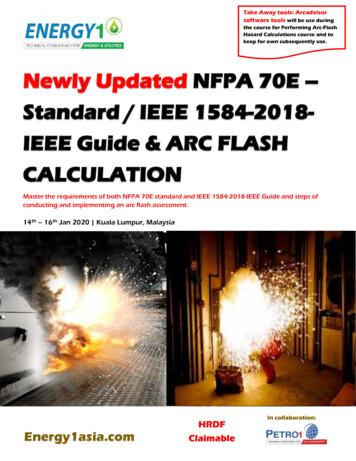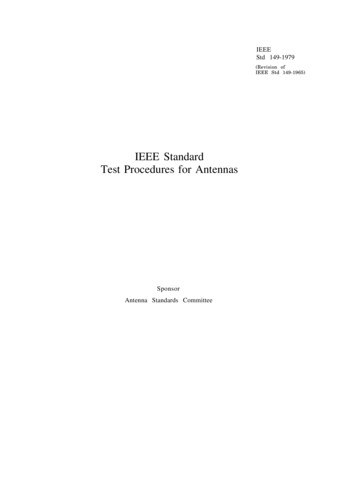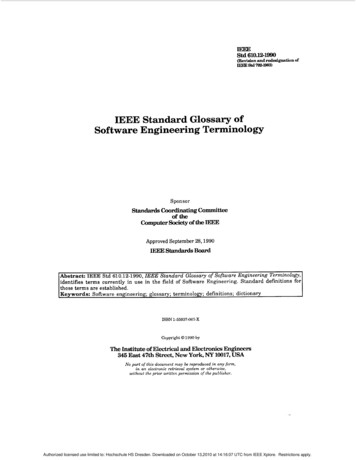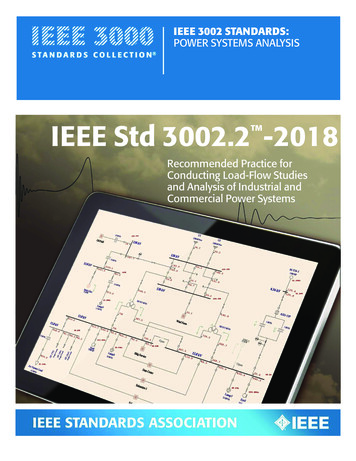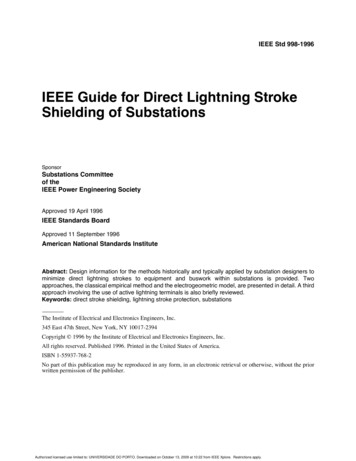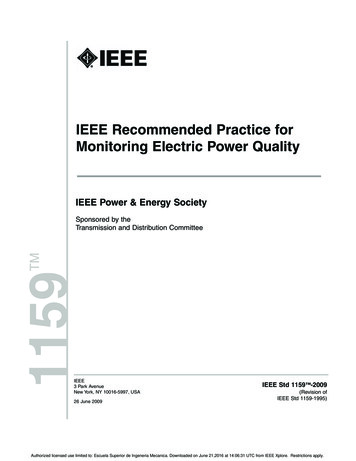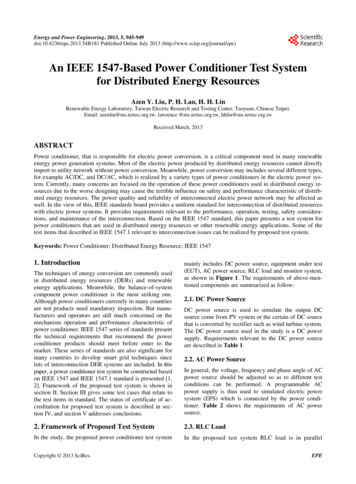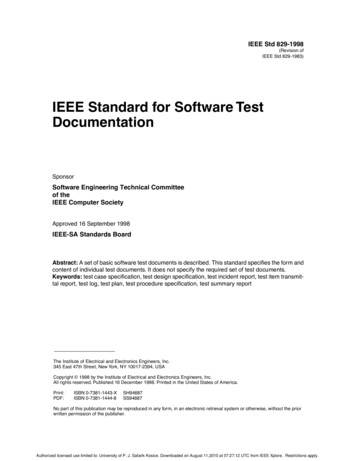
Transcription
IEEE Std 829-1998(Revision ofIEEE Std 829-1983)IEEE Standard for Software TestDocumentationSponsorSoftware Engineering Technical Committeeof theIEEE Computer SocietyApproved 16 September 1998IEEE-SA Standards BoardAbstract: A set of basic software test documents is described. This standard speciÞes the form andcontent of individual test documents. It does not specify the required set of test documents.Keywords: test case specification, test design specification, test incident report, test item transmittal report, test log, test plan, test procedure specification, test summary reportThe Institute of Electrical and Electronics Engineers, Inc.345 East 47th Street, New York, NY 10017-2394, USACopyright 1998 by the Institute of Electrical and Electronics Engineers, Inc.All rights reserved. Published 16 December 1998. Printed in the United States of America.Print:PDF:ISBN 0-7381-1443-XISBN 0-7381-1444-8SH94687SS94687No part of this publication may be reproduced in any form, in an electronic retrieval system or otherwise, without the priorwritten permission of the publisher.Authorized licensed use limited to: University of P. J. Safarik Kosice. Downloaded on August 11,2010 at 07:27:12 UTC from IEEE Xplore. Restrictions apply.
IEEE Standards documents are developed within the IEEE Societies and the Standards Coordinating Committees of the IEEE Standards Association (IEEE-SA) Standards Board. Members of thecommittees serve voluntarily and without compensation. They are not necessarily members of theInstitute. The standards developed within IEEE represent a consensus of the broad expertise on thesubject within the Institute as well as those activities outside of IEEE that have expressed an interest in participating in the development of the standard.Use of an IEEE Standard is wholly voluntary. The existence of an IEEE Standard does not implythat there are no other ways to produce, test, measure, purchase, market, or provide other goods andservices related to the scope of the IEEE Standard. Furthermore, the viewpoint expressed at thetime a standard is approved and issued is subject to change brought about through developments inthe state of the art and comments received from users of the standard. Every IEEE Standard is subjected to review at least every Þve years for revision or reafÞrmation. When a document is morethan Þve years old and has not been reafÞrmed, it is reasonable to conclude that its contents,although still of some value, do not wholly reßect the present state of the art. Users are cautioned tocheck to determine that they have the latest edition of any IEEE Standard.Comments for revision of IEEE Standards are welcome from any interested party, regardless ofmembership afÞliation with IEEE. Suggestions for changes in documents should be in the form of aproposed change of text, together with appropriate supporting comments.Interpretations: Occasionally questions may arise regarding the meaning of portions of standards asthey relate to speciÞc applications. When the need for interpretations is brought to the attention ofIEEE, the Institute will initiate action to prepare appropriate responses. Since IEEE Standards represent a consensus of all concerned interests, it is important to ensure that any interpretation hasalso received the concurrence of a balance of interests. For this reason, IEEE and the members of itssocieties and Standards Coordinating Committees are not able to provide an instant response tointerpretation requests except in those cases where the matter has previously received formalconsideration.Comments on standards and requests for interpretations should be addressed to:Secretary, IEEE-SA Standards Board445 Hoes LaneP.O. Box 1331Piscataway, NJ 08855-1331USANote: Attention is called to the possibility that implementation of this standard mayrequire use of subject matter covered by patent rights. By publication of this standard,no position is taken with respect to the existence or validity of any patent rights inconnection therewith. The IEEE shall not be responsible for identifying patents forwhich a license may be required by an IEEE standard or for conducting inquiries intothe legal validity or scope of those patents that are brought to its attention.Authorization to photocopy portions of any individual standard for internal or personal use isgranted by the Institute of Electrical and Electronics Engineers, Inc., provided that the appropriatefee is paid to Copyright Clearance Center. To arrange for payment of licensing fee, please contactCopyright Clearance Center, Customer Service, 222 Rosewood Drive, Danvers, MA 01923 USA;(978) 750-8400. Permission to photocopy portions of any individual standard for educational classroom use can also be obtained through the Copyright Clearance Center.Authorized licensed use limited to: University of P. J. Safarik Kosice. Downloaded on August 11,2010 at 07:27:12 UTC from IEEE Xplore. Restrictions apply.
Introduction(This introduction is not part of IEEE Std 829-1998, IEEE Standard for Software Test Documentation.)PurposeThe purpose of this standard is to describe a set of basic software test documents. A standardized test document can facilitate communication by providing a common frame of reference (e.g., a customer and asupplier have the same deÞnition for a test plan). The content deÞnition of a standardized test document canserve as a completeness checklist for the associated testing process. A standardized set can also provide abaseline for the evaluation of current test documentation practices. In many organizations, the use of thesedocuments signiÞcantly increases the manageability of testing. Increased manageability results from thegreatly increased visibility of each phase of the testing process.This standard speciÞes the form and content of individual test documents. It does not specify the required setof test documents. It is assumed that the required set of test documents will be speciÞed when the standard isapplied. Annex B contains an example of such a set speciÞcation.The readers of this standard are referred to Annex C for guidelines for using this standard to meet therequirements of IEEE/EIA 12207.1-1997, IEEE/EIA Guide for Information TechnologyÑSoftware lifecycle processesÑLife cycle data.OverviewThe documents outlined in this standard cover test planning, test speciÞcation, and test reporting.The test plan prescribes the scope, approach, resources, and schedule of the testing activities. It identiÞes theitems to be tested, the features to be tested, the testing tasks to be performed, the personnel responsible foreach task, and the risks associated with the plan.Test speciÞcation is covered by three document types:Ñ A test design speciÞcation reÞnes the test approach and identiÞes the features to be covered by thedesign and its associated tests. It also identiÞes the test cases and test procedures, if any, required toaccomplish the testing and speciÞes the feature pass/fail criteria.Ñ A test case speciÞcation documents the actual values used for input along with the anticipated outputs. A test case also identiÞes constraints on the test procedures resulting from use of that speciÞctest case. Test cases are separated from test designs to allow for use in more than one design and toallow for reuse in other situations.Ñ A test procedure speciÞcation identiÞes all steps required to operate the system and exercise thespeciÞed test cases in order to implement the associated test design. Test procedures are separatedfrom test design speciÞcations as they are intended to be followed step by step and should not haveextraneous detail.Test reporting is covered by four document types:Ñ A test item transmittal report identiÞes the test items being transmitted for testing in the event thatseparate development and test groups are involved or in the event that a formal beginning of test execution is desired.Ñ A test log is used by the test team to record what occurred during test execution.Ñ A test incident report describes any event that occurs during the test execution which requires furtherinvestigation.Ñ A test summary report summarizes the testing activities associated with one or more test design speciÞcations.Copyright 1998 IEEE. All rights reserved.iiiAuthorized licensed use limited to: University of P. J. Safarik Kosice. Downloaded on August 11,2010 at 07:27:12 UTC from IEEE Xplore. Restrictions apply.
Figure 1 shows the relationships of these documents to one another as they are developed and to the testingprocess they document.Figure 1ÑRelationship of test documents to testing processivCopyright 1998 IEEE. All rights reserved.Authorized licensed use limited to: University of P. J. Safarik Kosice. Downloaded on August 11,2010 at 07:27:12 UTC from IEEE Xplore. Restrictions apply.
TerminologyThe words shall, must, and the imperative form identify the mandatory material within this standard. Thewords should and may identify optional material.AnnexesThe examples found in Annex A are meant to clarify the intent of the document descriptions found in thestandard. Some suggestions about implementing and using the standard are in Annex B. Guidelines forcompliance with IEEE/EIA 12207.1-1997 are provided in Annex C.AudienceThis standard should be of interest to software users and software procurement personnel; to development,test, and maintenance personnel; to operations and acquisition support managers; to software quality assurance personnel and auditors; and to participants in the legal system.ParticipantsThis revision was prepared by the Life Cycle Data Harmonization Working Group of the Software Engineering Standards Committee of the IEEE Computer Society. At the time this standard was approved, the working group consisted of the following members:Leonard L. Tripp, ChairEdward ByrnePaul R. CrollPerry DeWeeseRobin FralickMarilyn Ginsberg-FinnerJohn HarauzMark HenleyDennis LawrenceDavid MaiborRay MilovanovicJames MooreTimothy NiesenDennis RillingTerry RoutRichard SchmidtNorman F. SchneidewindDavid SchultzBasil SherlundPeter VoldnerRonald WadeThe following persons were on the balloting committee:Syed AliH. Ronald BerlackRichard E. BiehlSandro BolognaJuris BorzovsAudrey C BrewerKathleen L. BriggsM. Scott BuckMichael CaldwellJames E. CardowJaya R. CarlEnrico A. CarraraLawrence CatchpoleKeith ChanAntonio M. CicuTheo ClarkeSylvain ClermontRosemary ColemanVirgil Lee CooperW. W. Geoff CozensPaul R. CrollPatricia W. DaggettGregory T. DaichCopyright 1998 IEEE. All rights reserved.Geoffrey DarntonTaz DaughtreyBostjan K. DergancPerry R. DeWeeseEvelyn S. DowCarl Einar DragstedtCharles DrozSherman EaglesLeo EganRichard L. EvansWilliam EventoffRichard E. FairleyJohn W. FendrichJay ForsterKirby FortenberryEva FreundRichard C. FriesRoger U. FujiiDavid GelperinAdel N. GhannamMarilyn Ginsberg-FinnerJohn Garth GlynnJulio Gonzalez-SanzL. M. GuntherDavid A. GustafsonJon D. HagarJohn HarauzHerbert HechtDebra HerrmannUmesh P. HiriyannaiahJohn W. HorchJerry HullerPeter L. HungGeorge JackelenFrank V. JorgensenVladan V. JovanovicWilliam S. JunkGeorge X. KambicRon S. KenettJudith S. KernerRobert J. KierzykShaye KoenigThomas M. KuriharaJohn B. LaneJ. Dennis LawrenceRandal LeavittvAuthorized licensed use limited to: University of P. J. Safarik Kosice. Downloaded on August 11,2010 at 07:27:12 UTC from IEEE Xplore. Restrictions apply.
Fang Ching LimWilliam M. LivelyJohn LordStan MageeDavid MaiborHarold MainsRobert A. MartinMike McAndrewPatrick D. McCraySue McGrathJacques MeekelJames Bret MichaelAlan MillerCelia H. ModellJames W. MoorePavol NavratMyrna L. OlsonIndradeb P. PalAlex PolackPeter T. PoonLawrence S. PrzybylskiKenneth R. PtackAnn E. ReedyAnnette D. ReillyTerence P. RoutAndrew P. SageHelmut SandmayrStephen R. SchachHans SchaeferNorman SchneidewindDavid J. SchultzLisa A. SelmonRobert W. ShillatoDavid M. SiefertCarl A. SingerNancy M. SmithAlfred R. SorkowitzDonald W. SovaLuca SpotornoJulia StesneyFred J. StraussChristine Brown StrysikSandra SwearingenToru TakeshitaRichard H. ThayerBooker ThomasPatricia TrellueLeonard L. TrippTheodore J. UrbanowiczGlenn D. VenablesAndre Villas-BoasUdo VogesDelores WallaceWilliam M. WalshJohn W. WalzCamille S. White-PartainScott A. WhitmireP. A. WolfgangPaul R. WorkNatalie C. YopconkaJanusz ZalewskiGeraldine ZimmermanPeter F. ZollWhen the IEEE-SA Standards Board approved this standard on 16 September 1998, it had the followingmembership:Richard J. Holleman, ChairSatish K. AggarwalClyde R. CampJames T. CarloGary R. EngmannHarold E. EpsteinJay Forster*Thomas F. GarrityRuben D. GarzonDonald N. Heirman, Vice ChairJudith Gorman, SecretaryJames H. GurneyJim D. IsaakLowell G. JohnsonRobert KennellyE. G. ÒAlÓ KienerJoseph L. KoepÞnger*Stephen R. LambertJim LogothetisDonald C. LoughryL. Bruce McClungLouis-Fran ois PauRonald C. PetersenGerald H. PetersonJohn B. PoseyGary S. RobinsonHans E. WeinrichDonald W. Zipse*Member EmeritusValerie E. ZelentyIEEE Standards Project EditorviCopyright 1998 IEEE. All rights reserved.Authorized licensed use limited to: University of P. J. Safarik Kosice. Downloaded on August 11,2010 at 07:27:12 UTC from IEEE Xplore. Restrictions apply.
Contents1. Scope. 12. References. 23. Definitions. 24. Test plan. 34.1 Purpose.
Ñ A test log is used by the test team to record what occurred during test execution. Ñ A test incident report describes any event that occurs during the test execution which requires further investigation. Ñ A test summary report summarizes the testing activities associated with one or


